There is definitely something about the country house milieu and atmosphere which appeals to me in crime fiction. From their isolated locales, often caused by poor weather, to the fact that there is usually a small group of characters focused on, who frequently pretend to be one thing and are invariably something or someone else altogether. Furthermore, this small group of characters commonly don’t get on with each other, yet are forced to socialise with one another – a narrative facet which can often be funny and interesting from a psychological point of view. Sometimes such awkward situations happen unintentionally, but more frequently they are planned by diabolically minded hosts such as in Death and the Dancing Footman (1942) or by more well intentioned country house owners such as in The Mystery at Stowe (1928).
Something else I have noticed in my reading this year is that the country house and its inhabitants can be used by writers to symbolise the state of the nation or to reflect social changes and issues such as in Joanna Cannan’s Murder Included (1950). Catherine Aird in The Oxford Companion to Crime and Mystery Writing (1999) says that the ‘actual decline of the country house is seldom documented in detective fiction,’ (Aird, 1999: 94-95 (94)). I disagree with this as not only is Murder Included an example of a mystery novel showing landed gentry taking in paying guests to pay the bills, but in my list of favourite country house mystery novels below, there is more than one example of a country home in decline. Equally in June Wright’s So Bad a Death (1949) and Eilís Dillon’s Sent to His Account (1954), the country house novel can become a vehicle for social, cultural, class and genre critique. Over the last century there have been many changes to how country houses are used, which is subtly depicted in Anthony Horowitz’s Magpie Murders (2016), where the country home is no longer an inherited possession and an integral part of the local village, but becomes the retreat of the nouveau riche.
Whether it involves Christmas parties, sinister building histories and the odd secret passage or two, the country house novel when done well is always a treat. Here are a few of my favourite country house mysteries, in no particular order:
- Case for Three Detectives (1936) by Leo Bruce
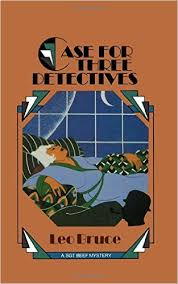
This is definitely an enjoyable instance of the comic country house mystery, where some of our favourite sleuths and detective fiction tropes are parodied well.
2. An English Murder (1951) by Cyril Hare

Hare’s novel is an excellent example of the country house novel as a social/cultural critique and the changing times are reflected well. The cast of characters are psychologically intriguing even if they aren’t very likeable. Like all good country house mysteries the country house is snow bound and tensions between the characters run high. The central crime also has a clever motivation behind it.
3. Let him Lie (1940) by Ianthe Jerrold

The main attraction for me in this novel is the central amateur sleuth, Jeanie Halliday, who I found to be a young Miss Marple in training. She picks up a lot of information through conversation and she receives a number of confidences. In some ways the country house in this novel takes on a symbolism of security, the result of an advantageous marriage, yet as the novel progresses it seems such security has its risks and disadvantages of its own.
4. Penhallow (1942) by Georgette Heyer

Heyer is not everyone’s cup of tea but I think this is one of her strongest crime novels, even if it is probably her longest. The atmosphere of this novel differs from her others. It is less cosy, less comfortable and what makes this novel stand out for me is the ending, an ending which I would never have expected of Heyer.
5. What Happened at Hazelwood? (1946) by Michael Innes

I have never been a major fan of Innes’ work but this is probably my favourite Innes novel. The police investigation is well written, the country house itself is interwoven into the central crime cleverly and I also think the characterisation works well.
6. Some Must Watch (1933) by Ethel Lina White
I feel like this has been a novel I have been talking about a lot lately but it is a brilliant book nevertheless. A storm rather than snow makes the central country house become isolated and cut off and again the house itself is effectively used well in the story to heighten the drama and tension. A country house after dark is definitely a scary place to be.
7. Murder at Shots Hall (1945)by Maureen Sarsfield
It is a shame that Sarsfield did not write more crime novels as this is an enjoyable country house murder with an engaging independent female protagonist, who arguably steals the limelight from the story’s central sleuth. Additionally as the front cover info suggests this is not a country house in its heyday but one definitely in decline.
8. The Case of the Abominable Snowman (1941) by Nicholas Blake
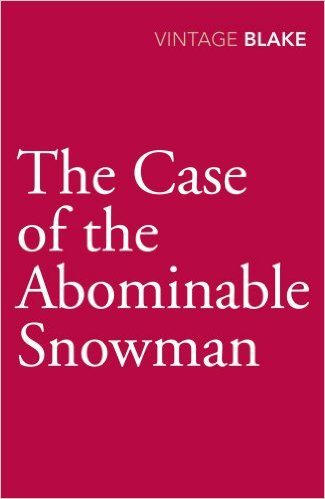
As the title suggests this is a wintery country house mystery, a situation which Blake uses to full and gruesome effect in the story. Being an earlier Blake novel the central puzzle is good and Nigel Strangeways, the central sleuth, is still his usual likeable and non-creepy self.
9. Envious Casca (1941) by Georgette Heyer

Contrary to the front cover shown this is another Christmas set country house mystery novel and it was my first introduction to Heyer’s work. The usual country house murder mystery ingredients can be found here including the tyrannical country house owner and the guests who can’t stand the sight of each other.
10. The Affair of the Mutilated Mink (1981) by James Anderson
A return to the comic country house novel and Anderson in fact wrote three pastiches of this subgenre, but this one is probably my favourite. Anderson’s humorous and fun writing style works well and I think he uses the tropes and stock characters of the subgenre in an amusing and effective manner.
11. The Red House Mystery (1922) by A. A. Milne
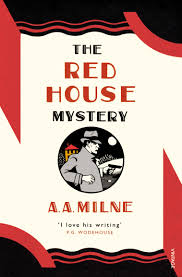
This is one which I read soon after I turned to reading crime fiction and although in retrospect I have been informed of some implausibility of plot events, it is still a book I enjoy and is one I would like to return to for a reread.
12. The Franchise Affair (1948) by Josephine Tey
This novel by Tey certainly dismantles the expectation of country house mysteries being cosy and the isolated aspect of the country house has unfortunate consequences for its occupants in this story.
13. Speedy Death (1929) by Gladys Mitchell
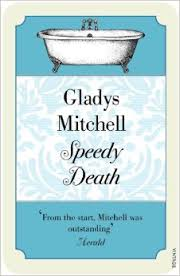
One of my favourite Mitchell novels, though not to everyone’s taste. It certainly overturns your expectations of how a detective should act and I also enjoyed its exploration of gender and gender roles. In a way the country house and its social expectations have a poisonous effect on at least one of its’ inhabitants.
14. Clouds of Witness (1926) by Dorothy L Sayers

An early Lord Peter Wimsey novel with a case more personal than Wimsey would like. Although Sayers is said to have been in love with Peter, she certainly doesn’t hold any punches when it comes to Wimsey’s brother, the Duke of Denver, whose behaviour does not do many favours for the image of aristocratic country house owners. In fact I think he comes across as quite anarchic at times, which reflects back to the country house itself and the way of life that went with it.
Where are the Christie novels you say? Considering how many of hers I enjoyed I decided to give her a list of her own.
- The Mysterious Affair at Styles (1920)
Perhaps a rather expected choice but a good place to start nonetheless, Christie’s first Poirot novel. A mystery with a number of clever clues Poirot interprets correctly and this is a story which depicts the downsides of living with too many relatives, many of which are hiding behind façades.
2. Curtain (1975)

This is an important novel for many reasons but I think it is an interesting one to read in light of The Mysterious Affair at Styles, as the same country house is used, though in the later book it has undergone many changes, which again refute Aird’s notion. Such changes are also paralleled in the characters themselves and the country house is not the only thing which is declining.
3. Five Little Pigs (1942)

Although not automatically categorised as a country house mystery, the Crale home, amongst others can be seen as such houses. Once more the country house owner in the guise of Meredith Blake, comes under scrutiny and is portrayed as not being able to adapt to the changing times. This is also a brilliant book to read for its characterisation and character psychology.
4. The Secret at Chimneys (1925)
I wouldn’t say this is Christie’s strongest work but it is a story I remember reading and finding a great deal of fun, more in the thriller vein rather than a detective novel. Like some of the other stories I have mentioned, the house itself gets to take an intrinsic part in the plot which I also liked.
5. Hercule Poirot’s Christmas (1938)

An enjoyable winter country house mystery which includes an unusual murder method and is one I remember favourably for its surprising choice of murderer.
6. Crooked House (1949)

Like Tey’s The Franchise Affair, the expected cosy atmosphere of the golden age country house novel is debunked, with its unsettling character psychology, its modern choice of killer and its unconventional and dramatic ending.
7. The Mouse Trap (1952)
This is a play I loved seeing a couple of years ago and I was extra pleased with myself for having guessed the culprit in the interval (a definite fluke). Snow once more cuts the country house off from outside support and again the country house is opened to paying guests, which reveals the changing role of country houses.
8. Ordeal by Innocence (1958)
As with Crooked House, this is an unsettling story which begins with the admittance of a miscarriage of justice and the country house is not an idyllic place to live, especially in this one which is harbouring a person who thought they had got away with murder. I also think in this story that the country house reflects failed ambitions and dreams, as in such a home the original murder victim Rachel Argyle plans to create a nurturing and loving environment for her adopted children. Yet as the novel shows this plan does not really succeed, with wealth not generating the expected sincere affection between parent and child.
9. And Then There Were None (1939)
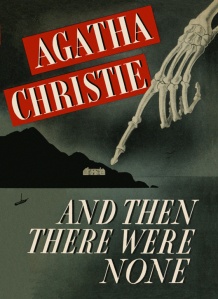
This is not one I immediately thought of as a country house mystery, but yet on closer scrutiny it does seem to meet the criteria. The island provides a rural and cut off location for the country house itself and animosity between the people on the island soon breaks out as they are forced to live together, all the while wondering which one of them is the murderer. This book is brilliant for so many reasons that listing them would take up a post in itself but in short it is amazing for its characters, tension, setting and psychology and is one everyone should try.
I was tempted to add Sad Cypress (1940) to the list as it is one of my favourite Christie novels, but I wasn’t sure how much of a country house mystery it was and in the end I concluded that the reasons I loved it weren’t really to do with its’ setting as such, so I decided to keep it out of the list.
Finishing this post I am aware I have probably forgotten numerous other good country house mystery novels so do feel free to mention them in the comments section below.








“The actual decline of the country house is seldom documented in detective fiction.” Christie shows us country houses that are turned into flats, glamorous homes for film stars, or institutions for young offenders.
LikeLiked by 2 people
Darn it you’ve made me think of more Christie country house mysteries that I had forgotten about! Trying to create a Christie list for anything is always difficult, as you always keep thinking of just one more…
LikeLike
Yes, Kate, I’m surprised at you! Gossington Hall in St. Mary Mead is one of the best country homes, particularly since it’s the only one that is seen over and over again. Watching it evolve from The Tuesday Night Club to The Body in the Library to its renovation in The Mirror Crack’d From Side to Side is one of the great pleasures of the Miss Marple mysteries. Yew Tree Lodge is another fine home with an obnoxious family in A Pocketful of Rye, as is Rutherford Hall in 4:50 From Paddington. And let’s not forget my favorite Poirot – After the Funeral – as the family faces selling off the mansion to U.N.E.S.C.O. The list goes on.
But you came up with great examples! I agree that the second Anderson pastiche is the best. The Affair of the Bloodstained Egg Cozy is lots of fun, but it throws in every mystery trope there is and ends up being a so-so mystery, while the Moth-Eaten Mink is a better tale.
When I was growing up, I loved creating my own British country homes, drawing maps and inventing the cast of characters of my own original mysteries (none of which I ever actually wrote). But I used to have stacks and stacks of paper with charts and maps and lists like:
MURDER AT MABERLY HALL
(Cast of Characters, in order of appearance)
Sir Cedric Maberly – Little did this fussy old man think when he retired from the banking business that he would host a weekend filled with . . . murder!
Millicent Maberly Sykes – Sir Cedric’s sister, a somber woman, always dressed in black, who is devoted to contacting her ex-husband . . . from beyond the grave!!!
Ronald Maberly – Sir Cedric’s elder son and heir, whose dissolute lifestyle makes him unfit to assume the mantle of Master of Maberly Hall!
And so on . . .
What fun I had, and how much I love a good country home mystery!
LikeLiked by 2 people
Yes I have come to the conclusion that creating a Christie list is impossible. I was tempted by The Body in the Library but I felt that the action took place more at the hotel resort place than it did at Gossington hall. I had forgotten about The Mirror Crack’d From Side to Side, A Pocket Full of Rye and 4:50 from Paddington. I had remembered After the Funeral but it is not such a favourite for me and I was trying to concentrate on my favourite Christie country house mysteries.
I definitely think you would have been the friend I would have loved to have had when I was child, as your country home inventing and characters list sound like a lot of fun, heck they’d be fun to come up with now. Have you kept many of your original character casts?
LikeLike
I too love a good country house mystery…though a lot of my faves are newer than your list as I don’t read as many classics. I recently re-read AND THEN THERE WERE NONE though and think it definitely fits the confines of the sub-genre – plus it is excellent. It’s easy to forget Christie could be seriously dark.
I’m actually not a huge fan of P.D. James (Dalgliesh is really way too pompous for this working class Aussie girl) but her first – COVER HER FACE – is a good example of the genre – it was written in the early 60’s and still has elements of the golden age detective stories (there’s even a shell-shocked war hero in there) but is also showing signs of modernity – especially the family belonging to the stately home being in what I think would politely be called ‘reduced circumstances’.
One of my favourites from recent years is Anne Holt’s 1222 – a train derails in the Norwegian mountains and the passengers are all schlepped to a nearby hotel which is cut off from civilisation by the weather – it’s not perfect (I think the author was trying a bit too hard to pay homage to the greats) but it’s an above average example of a modern take on the concept.
An Australian author who is no longer writing mysteries (she’s moved on to young adult and kids’ mysteries like almost everyone else seems to be doing) called Jennifer Rowe wrote a short series featuring an amateur private investigator who got herself invited to several murderous houses. My favourite was the first – called GRIM PICKINGS – set in a family apple orchard in a town I once lived in (in the Blue Mountains west of Sydney).
LikeLiked by 1 person
Great suggestions. I had forgotten about P D James, though she is not one of my favourite writers. I’ve been looking for some new non UK and USA crime fiction so your Rowe and Holt recommendations have been well timed and from their blurbs they sound good. Thanks.
LikeLike
[…] Country House Mysteries – Some of my Favourites […]
LikeLike
[…] the two World Wars. I found several “best” lists online, such as this one from the blog Crossexamining crime, and this from The Strand Magazine. Regarding the first, having recently finally gotten around to […]
LikeLike
[…] The Valley of Fear, as well as commenting on a list I wrote back on the blog in 2016 about some of my favourite country house mysteries. One of the things which struck me the most was that I couldn’t remember what titles I had put on […]
LikeLike
The Little Stranger by Sarah Waters is one of my favorite books. It’s not really in the mystery genre, but it has the atmospheric country house that is like a character in the story.
LikeLiked by 1 person
Thanks for the tip! Interesting to hear about a non-mystery one.
LikeLike
I really liked her Fingersmith, and recommend it wholeheartedly to Kate.
(And not as payback for recommending this abominable Abominable Snowman book! 😉)
LikeLike
Well, I just finished The Corpse In The Snowman. I am speechless at how bad it is. I cannot discuss its worst flaws without spoilers but it has one of the worst cheats in GAD. And that is only half of what is wrong with it.
LikeLike
Sorry the book didn’t work out for you, can’t win them all. Not re-read this one yet, so it’ll be interesting to see how it fairs on a second reading. Memories fairly woolly on this one apart from a central image shall we say.
LikeLike
What about Liane Moriarty’s Nine Perfect Strangers? It takes place at a renovated country house that’s now a health resort.
LikeLiked by 1 person
I have not read anything by that author before, but a renovated country house would certainly fit the country house mystery theme. What did you enjoy about that book?
LikeLike
I liked the book overall. Breaking down each person’s reasons for being “stuck” showed them how every thing they did caused an adverse reaction to their wellness. And then there was Masha, the crazy leader of the resort. She had some strange ideas about health and wellness.
LikeLiked by 1 person